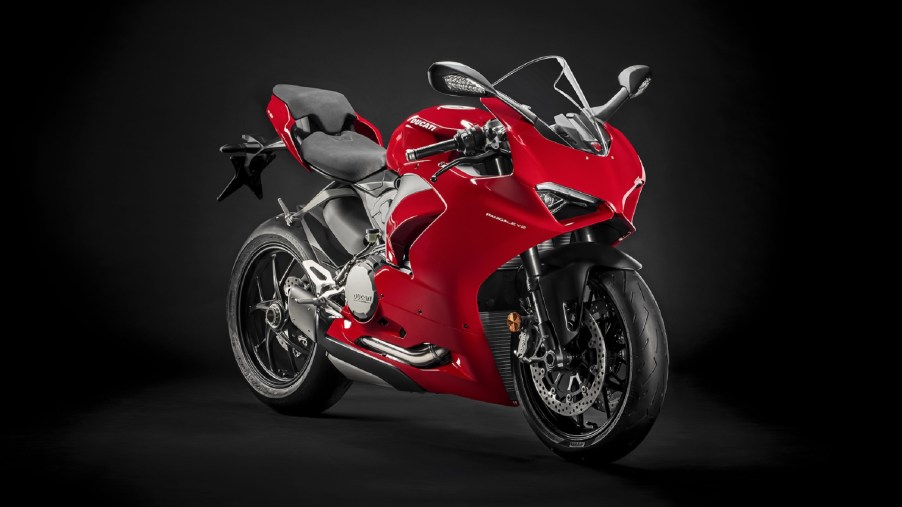
Even Without the V4, the Ducati Panigale V2 Is Plenty Fast
Before the Panigale V4, Ducati’s sportiest bikes all used the Italian brand’s 90° V-twin, aka ‘L-twin,’ engine. And, to be fair, it’s not like the company abandoned that engine completely. The rest of its lineup, from the Scrambler to the Diavel cruiser, all use L-twin engines. And you can still get a Panigale with it. But just because it lacks the V4, doesn’t make the Ducati Panigale V2 slow.
2020 Ducati Panigale V2 specs and features

An evolution of the 959 Panigale, the $16,495 2020 Ducati Panigale V2 has quite a few updates over the outgoing model. Which includes its eponymous engine.
The Panigale V2 has a 955cc V-twin (‘L-twin’), making a claimed 155 hp and 77 lb-ft. The 959, at one point, was claimed to produce 157 hp, Motorcyclist reports, from its 955cc engine. However, it turned out the dynamometer wasn’t calibrated correctly. Ducati claims the Panigale V2 makes 5 more hp than the 959, Autoweek reports. The engine’s linked to a 6-speed manual with a slipper clutch and an electronic quick-shifter, Cycle World reports. Said quick-shifter also allows for clutch-less downshifts and even an auto-blip function.

In addition to the updated engine, the Ducati Panigale V2 also ditches its predecessor’s double-sided swingarm for a new single-sided one, Revzilla reports. This allows for faster tire changes when you’re on the racetrack. Both the front forks and rear suspension have been updated, too, Cycle World reports.
Some of the Panigale V4’s features are found on the V2 model as well. For one, there’s the overall styling. Secondly, there’s the technology. The Panigale V2 gets the V4’s 4.3” TFT display, as well as its adjustable wheelie, traction, and engine braking controls. The ABS is adjustable, too, and even adjusts itself based on the bike’s lean angle. These systems linked to the V2’s riding modes, but the rider can adjust each system independently within each mode.
Riding the Ducati Panigale V2
The Ducati Panigale V2 is definitely slower than the V4 model, Motorcyclist reports. The V4 is up about 59 hp, and actually weighs about 5 pounds less. Still, with 155 hp moving 441 pounds, there’s a reason why large-capacity motorcycles aren’t great first bikes. And arguably what’s most impressive about the Panigale V2 isn’t out-right speed, but how well it manages that speed.
On a track, Revzilla reports, the bike is planted and stable. With less power to work with, the electronics are less obtrusive and obvious. Plus, with the auto-blip, clutch-less downshifts, and all the safety nets, you almost have to deliberately screw up a corner. But even when traction control and ABS are turned off, the Panigale V2’s chassis and suspension make it very approachable.
On the road, Ducati’s smaller Panigale does show some flaws. The suspension and seat, though less stiff than on the V4, aren’t great on pot-holed roads. It can still be used as a commuter, as long as you’re OK with the very laid-out riding position. And the heat which comes from an under-seat exhaust. In addition, over bumps, the V2 feels a bit less settled, Motorcyclist reports, than the V4. But on a well-maintained curving road, it’s still a lot of fun.
Albeit somewhat pricey.
How does the competition compare?
The Ducati Panigale V2’s biggest problem isn’t its engine output, but rather its relative output. For about the same price, you can get a number of bikes that simply make more power.

The 205-hp BMW S1000RR, for example, costs $1000 more. Meanwhile, the Kawasaki Ninja ZX-10R has basically the same electronics but costs $400 less. And it has 197 hp, Autoweek reports. So, if you’ve been riding larger-capacity sportbikes for some time, the Panigale V2 may be a step down in terms of speed.

But, if you’re looking to step up from, say, a Ninja ZX-6R, the Panigale V2 is a great way to break into the sportier segment. It’s got all the speed you’ll really need, and the electronics to help you build up confidence.
Follow more updates from MotorBiscuit on our Facebook page.


